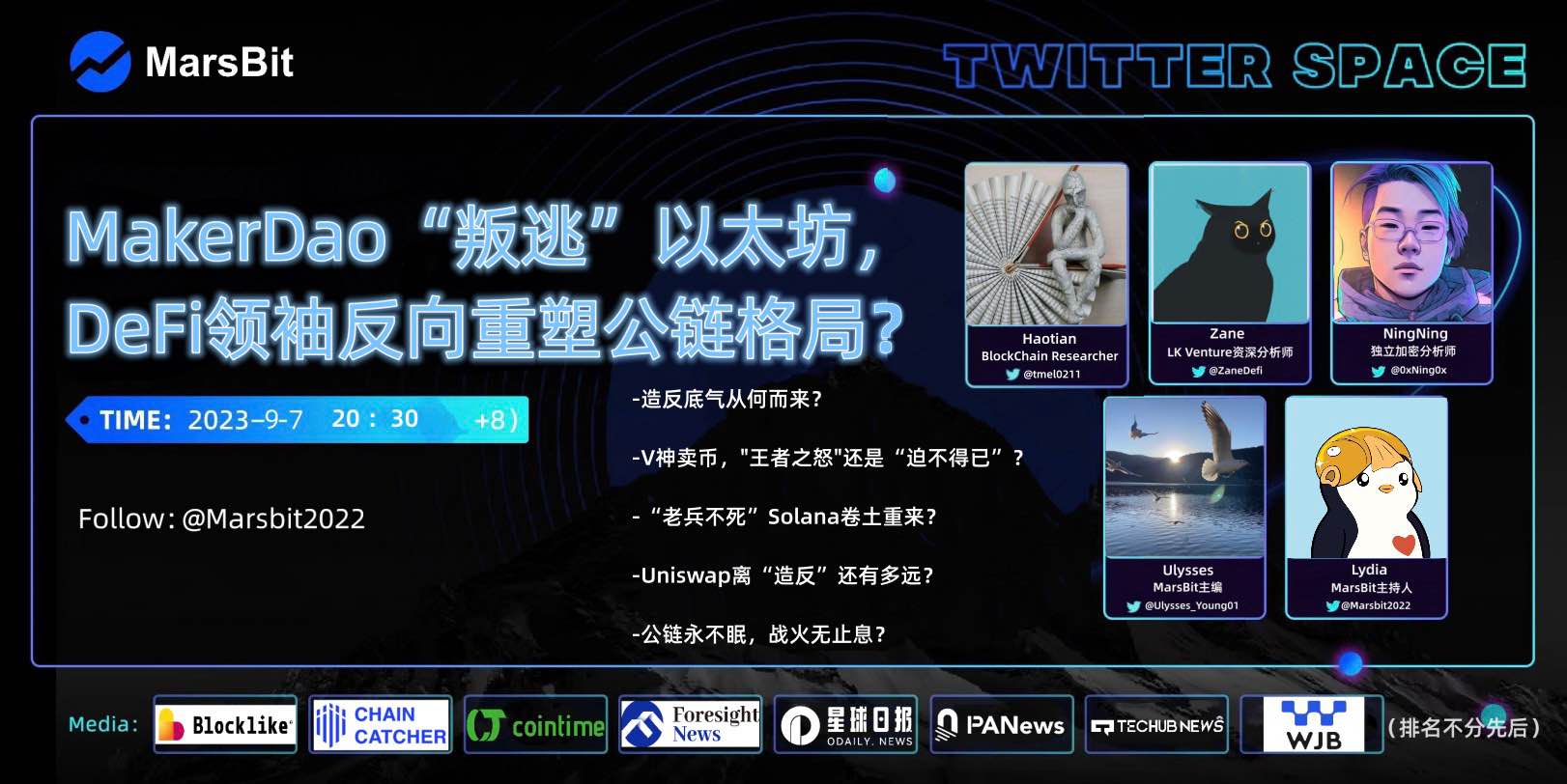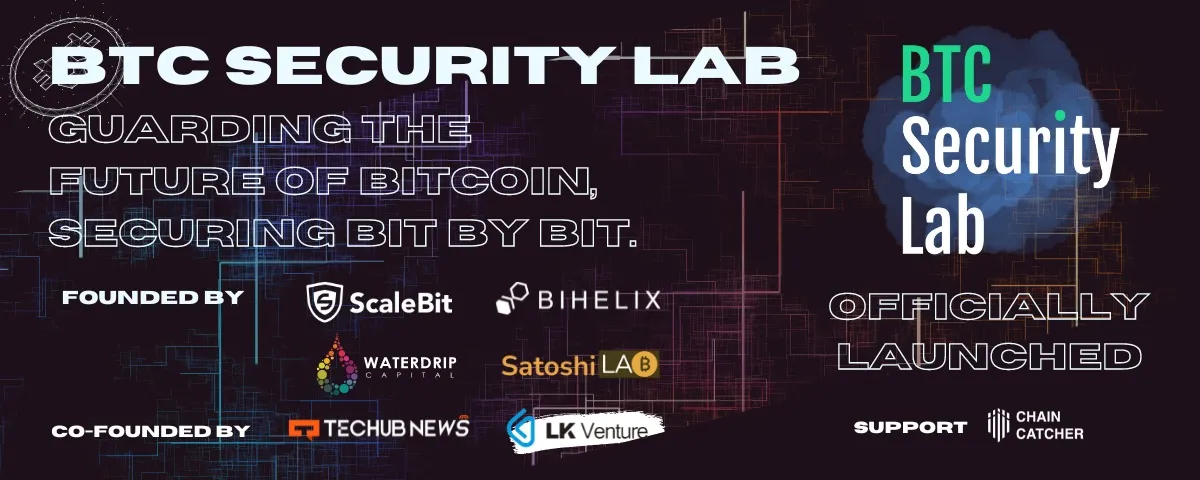MarsBit held a special discussion on X-Space about the MakerDao event, gathering KOLs to interpret the ins and outs of the crypto world
Organizer: MarsBit
On September 7 at 20:30, the MarsBit special X (Twitter) Space was broadcast as scheduled. LK Venture senior analyst Zane, independent crypto analyst NingNing, blockchain researcher Haotian, and MarsBit editor-in-chief Ulysses gathered to discuss the recent industry attention sparked by MakerDao's intention to "defect" from Ethereum and deploy a New chain on Solana, providing a comprehensive interpretation of the implications and market changes behind this event.
 As this topic focused on the biggest market concern recently, the event directly entered the climax of the discussion at the beginning, with continuous entries into the live room, leading to nearly 2 hours of discussion.
As this topic focused on the biggest market concern recently, the event directly entered the climax of the discussion at the beginning, with continuous entries into the live room, leading to nearly 2 hours of discussion.
The dialogue covered five main topics: "Where does MakerDao's rebellious confidence come from?", "Did Vitalik sell coins out of anger or necessity?", "Veterans do not die, Solana makes a comeback", "How far is Uniswap from rebellion?" and "Public chains never sleep, the war never ends".
From the very beginning, the conversation was characterized by clear viewpoints and a direct approach to the topic.
LK Venture senior analyst Zane first addressed the incident of MakerDAO's desire to "rise up and establish its own path," reviewing the development history of this DeFi OG protocol. He stated that an important reason for MakerDao to build a NewChain is to allow the ecosystem to hard fork and repair significant attacks. The so-called rebellious confidence is actually out of necessity, as the Ethereum mainnet cannot hard fork to recover assets, so Rune must create his own chain. Therefore, it cannot be called "rebellion," as most assets still reside on the Ethereum chain, which actually reflects a positive outlook on technology.
Haotian believes that MakerDao has indeed made significant contributions to the Ethereum community. While it cannot be said that MakerDao has achieved Ethereum, it has absolutely achieved DeFi. This immense contribution has led to MakerDao's current great ambition. In fact, even before the Wormhole hack, MakerDao faced criticism for using very centralized methods to handle issues, including recently using digital assets to buy U.S. Treasury bonds; these rebellious actions reflect its ambition.
The crypto community has generally expressed dissatisfaction and skepticism regarding MakerDAO's plan to "defect" from Ethereum. Among them, Ethereum founder Vitalik directly took action—selling 500 MKR—to show his discontent. The community's reactions to this opinion leader's actions have been mixed.
NingNing believes that since the secondary market allows for free buying and selling, Vitalik also has this freedom, and there is no need for value judgment. The discussion of new chain alternatives by MakerDao is within a rational scope; the reason it has sparked huge controversy is that it touches on a problem everyone wants to avoid, namely the severe politicization of the Ethereum community. Under normal circumstances, the industry should be viewed from the perspective of products and technology; once political noise arises, it will be affected.
Ulysses believes that Vitalik's sale of coins is primarily a statement of attitude, firmly opposing MakerDao's actions. Whether MakerDao's behavior is rebellious or an escape, it can be seen as an act of "self-destruction" for Ethereum. Currently, Ethereum dominates the landscape, and the situation is clear; Vitalik is also determined to succeed. MakerDao's departure affects this situation, and if everyone does the same and establishes their own public chains, Ethereum, as the most widely used underlying infrastructure, will suffer significant damage. Therefore, Vitalik's anger is undoubtedly genuine.
In addition to Vitalik and Ethereum, this incident also involves two other players: Solana and Cosmos. Independent crypto analyst NingNing shared his views on these two chains from a product performance perspective. He believes that the term decentralization has been imbued with too much ideological color, sometimes used as a banner for mutual attacks. Solana scores much higher than Ethereum in certain dimensions, such as the Satoshi index, so the degree of decentralization of Ethereum may not be as high as commonly perceived; it should be viewed from a diversified perspective. The main criticism of Solana's centralization is its potential for outages, but the impact is not severe. Therefore, Rune's choice of Solana may not necessarily relate to centralization or decentralization; rather, he aims to create a completely self-sustaining and self-consistent protocol, a need that cannot be met by Ethereum, prompting his shift to Solana.
Zane directly stated that he really likes the Solana public chain. Solana is considered a weakly centralized public chain due to node issues, but this does not hinder various ecosystems from developing on Solana. Excluding TVL data, Solana is actually the best-performing public chain in terms of ecosystem development besides Ethereum, with many innovative GameFi and NFT projects being more suitable for Solana. After FTX's collapse, Solana dropped to a very low price, but its ability to recover somewhat in the current sluggish market indicates resilience, suggesting it may perform well in the future.
Regarding the other public chain involved, Cosmos, Haotian believes the two are fundamentally different. Solana is building a highway, while Cosmos is creating a super city. Cosmos aims to establish a multi-chain ecosystem, laying the groundwork and connecting other application developers.
Although MakerDAO founder Rune later publicly explained that the choice of Solana was based on hard fork considerations, blockchain researcher Haotian believes that Rune has other intentions for MakerDAO's design. He pointed out that as the most native user of Ethereum, MakerDao does not develop Layer 2 applications for several technical reasons: first, Layer 2 is essentially a Rollup contract, affected by transaction limits. Second, Layer 2 is currently protected by Ethereum DA, so it must adhere to Ethereum's block capacity limits. Finally, if MakerDao wants to achieve absolute sovereignty, it cannot do so in the current Layer 2 environment. While relying on Ethereum for DA support is a good choice, he is unwilling to do so, indicating that MakerDao is drifting and looking for trouble.
In fact, MakerDao is not the first DeFi protocol to want to "escape" Ethereum; dydx is a precedent. However, Vitalik's reaction to MakerDao seems more direct and intense, which is related to the protocol's position in the DeFi market.
If the largest trading protocol in the DeFi market, Uniswap, were to "establish its own path," what impact would that have on Ethereum? Haotian expressed that Uniswap holds a significant share of the trading market, but that does not mean it will necessarily defect from Ethereum. All its actions, such as upgrading to V4, launching uniswapX, and upgrading the wallet, are actually aimed at gradually addressing Ethereum's shortcomings, ultimately leading to an upgrade and continued operation on the Ethereum chain. The true business landscape is one of cooperation and mutual achievement; the entire DeFi market is highly composable, and major players cannot overlook this.
In fact, when we discuss MakerDAO and Vitalik, we are more about the direction of OG DeFi protocols moving towards application chains and the changes they bring to the competitive landscape of public chains. If more mature DeFi protocols choose to "start anew" in the future, will this reshape the public chain market? Zane stated that there is no possibility of that. Ethereum's ecosystem is now mature, with the strongest consensus; from a security perspective, the first choice must be Ethereum. To compensate for Ethereum's shortcomings, there will be other options, such as other public chains and Layer 2, but although these protocols have expanded to other public chains, they are merely parasitic and do not overshadow Ethereum, nor do they have that capability.
The public chain landscape may be reshaped, but this will not happen in the DeFi field, as development is already very mature, and the ceiling for innovation is too low. However, Layer 3, which focuses on application chains, may be more likely to change the public chain landscape.
NingNing also expressed views on the development of new public chains like Sui and Aptos. He believes that new public chains pose no challenge to Ethereum. Their existence merely consolidates and strengthens Ethereum's core position in the Web3 network. Sui and Aptos have performed well in financing and have strong narratives, but in terms of users/TVL or their own capabilities, they are unlikely to challenge Ethereum, let alone Layer 2 or even older Layer 1 chains. The future market for Aptos and Sui is not visible under the established paradigm unless a new paradigm emerges.
Ulysses agreed with most of NingNing's views and provided another perspective. Public chains serve two purposes: financial infrastructure and Web3 infrastructure. As financial infrastructure, Ethereum's position is thoroughly solidified and will not be challenged by any public chain. However, considering the vast external entity of the financial world, Ethereum may not be very stable. In the entire Web3 market, the crypto market is a very small segment; if we consider a 10-point market, crypto might not even account for 1.
Regarding the highly anticipated L2 track, Zane stated that Layer 2 performs calculations and packages data, using Ethereum for mainnet recording, creating a symbiotic relationship with Ethereum for mutual growth.
In the final part of this event, the four guests made predictions about the future trends of the cryptocurrency market.
NingNing: The entire crypto asset field consists of tens of thousands of assets, with the highest quality assets yielding the greatest returns and the least risk, so Bitcoin must be included, followed by Ethereum, which is the core of the core. The rest can be chosen based on personal preference, preferably in popular sectors. However, attention should be paid to the concept of portfolio investment, avoiding putting all funds into a single asset. Also, consider effective asset allocation, such as calculating an effective asset ratio based on 200 days of trading data, which allows one to earn more than others in a rising market and lose less in a downturn. This enables more comfortable operational management.
The market is currently experiencing excessive FUD, showing clear bottom characteristics, but people are afraid to buy the dip due to a fear of fear itself. They worry that the bear market hasn't hit bottom yet and that Bitcoin might drop below 20,000. However, I am personally optimistic; Goldman Sachs reported that the Federal Reserve will not raise interest rates again, which is a significant external condition that has reached a turning point. Moreover, this round of the bear market is merely a secondary market bear market; developers and project teams are actively building across various sectors. Therefore, once the Federal Reserve's policy shifts, the market will naturally experience a value recovery trend.
Haotian: I focus on the technology sector; I cannot provide a bull market timeline, but we can discuss sectors of interest. Attention can be paid to Layer 2, ZK, and intent-centric sectors. Developers may bring new trends in these areas.
Zane: Besides ZK, I am quite optimistic about the opBNB track, which is currently overlooked, but it is part of Binance's strategy, so it is likely to develop.
As for the overall market, I don't think it is panic; rather, it is a very subdued sentiment with low attention. The upcoming market may change with external market fluctuations, such as global assets like U.S. stocks, which may either drop or rise, leading to what could be termed a major market trend.
Ulysses: Bitcoin will not crash significantly, but will there be another bull market? If so, will it be like the previous bull markets? I think it may be very different. The crypto market is becoming increasingly integrated with the internet and finance; the crypto world provides value to the internet and financial technology, and such projects will be valuable, but Bitcoin may just be like gold. Therefore, the future bull market will be a project value bull market, rather than a Bitcoin bull market.
Disclaimer: This article does not constitute investment advice. Users should consider whether any opinions, views, or conclusions in this article align with their specific circumstances and comply with relevant laws and regulations in their country or region.









